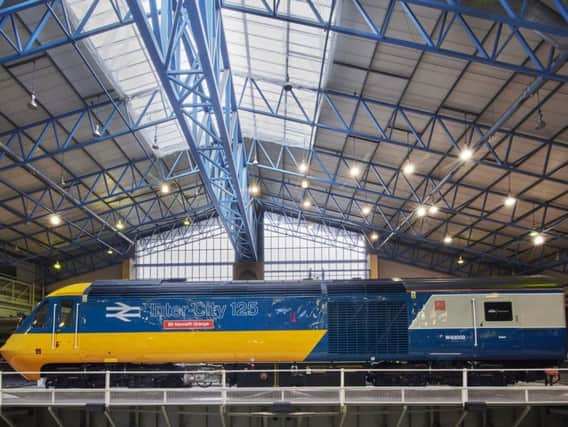The National Railway Museum in York's latest exhibit is an InterCity 125 diesel train from the 1970s


A Class 43 High Speed Train - popularly known as the InterCity 125 - has been donated by the Great Western Railway to mark the model's retirement from service this year.
The InterCity 125 diesels also worked the East Coast Main Line, serving Yorkshire destinations including Leeds and York since 1976.
Advertisement
Hide AdAdvertisement
Hide AdNational Railway Museum given huge cash boost to fund its expansion plansThe power car that is now part of the NRM's collection is number 43002, Sir Kenneth Grange, and was named after the locomotive's designer. It was the first HST off the production line and was given its name in 2016. It has been re-painted in its original British Rail livery.
The InterCity 125s shaved more than half an hour off the journey time between Newcastle and London King's Cross, and became the 'backbone' of high-speed mainlines. At one time they were the fastest trains in Europe and behind only the famous Japanese Bullet trains for speed. The class still holds the world diesel record of 148mph, which was set in 1987.
Almost 200 were built before production ended in 1982.
Their introduction to the network was said to have 'saved' British Rail during a troubled period in the 1970s when passenger numbers were in decline.
The original blue and yellow BR colour scheme led to the trains being nicknamed 'the yellow bananas' by travellers, who also became fond of their distinctive wedge-shaped nose cones.
Advertisement
Hide AdAdvertisement
Hide AdPoignantly, the power car that has now gone on display in the Great Hall was built in 1975, the same year the museum opened.
Pioneering steam engine Stephenson's Rocket has arrived at the National Railway MuseumNRM head curator Andrew McLean said:
“This is one of our most significant acquisitions, and I am delighted to be able to display the HST power car, Sir Kenneth Grange here in York. It is fair to say that this train revolutionised rail travel and helped shape British society, bringing people and communities together.
“I would like to thank Angel Trains, Great Western Railway and Rail Operations Group for their generosity and hard work to bring this icon of British engineering into the national collection.”
Advertisement
Hide AdAdvertisement
Hide AdGreat Western Railways managing director Mark Hopwood added:-
“This particular locomotive has been a firm favourite since we returned it to its original livery in 2016 and we are really pleased to see it joining the National Railway Museum’s collection. Our team at Laira Depot in Plymouth have done a fantastic job in preparing it for display and as the last locomotive to leave Paddington in passenger service, its place in history is rightly deserved.”
A Pacer train could go on display at the National Railway Museum in YorkThe InterCity 125s are currently in the process of being retired from service. London North Eastern Railway will replace them with new Japanese-built Azuma trains on the East Coast Main Line, while the Great Western Railway has opted for Hitachi's Class 800 Intercity Express.
The NRM has also expressed interest in taking a 1980s Pacer train to put on display when Northern phase them out in 2020.
.